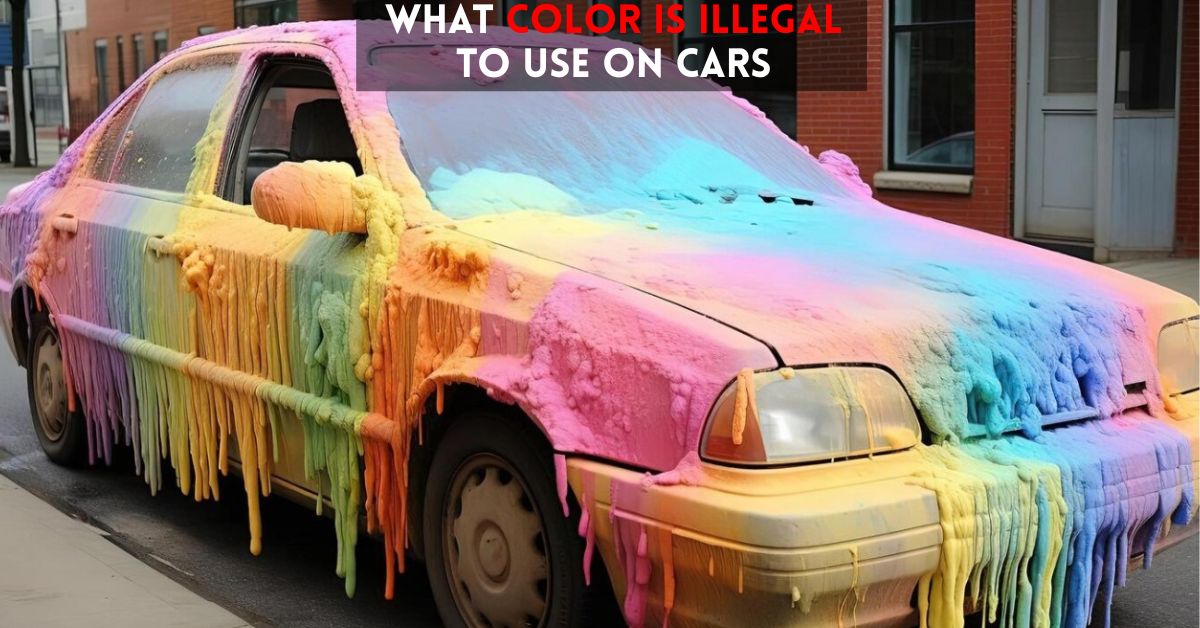What color is illegal to use on cars? This question often makes people imagine cars painted in neon green or other strange colors. But in reality, the rules about car colors are not about banning certain shades just because they look odd. Instead, the focus is on safety, proper identification, and preventing people from making their cars look like emergency vehicles. Generally, there are no laws that completely ban specific paint colors on private cars. You won’t find rules saying “yellow cars are not allowed” or “pink is illegal.” Most color restrictions only apply to vehicle lights or specific color placements that could cause confusion on the road.
Why Some Car Colors and Lights Are Regulated
The main reason for having rules about car colors and lights is to make sure vehicles are easy to identify and don’t cause confusion on the road. Emergency vehicles like police cars, ambulances, and fire trucks have special designs and unique light colors that make them easy to spot. This is important for public safety because it helps other drivers recognize them quickly and move aside when needed.
What Makes Certain Car Colors and Lights Illegal

This is where the idea of “illegal colors” really applies — not to the car’s paint, but to its lights. In most places, some light colors are reserved only for emergency vehicles. For example, red lights on the front of a car are almost always illegal because red is meant for the back (like brake lights) or for emergency vehicles like police and fire trucks. Similarly, blue lights, especially flashing ones, are usually only allowed on police cars. If a private car uses red or blue lights in a way that makes it look like an emergency vehicle, it can lead to heavy fines or even jail time. This is because it can seriously confuse other drivers and put public safety at risk.
Other Light Colors That May Be Restricted on Cars
Apart from red and blue, some places also have rules about other light colors on cars. For example, green lights might be reserved for volunteer firefighters or certain service vehicles. Amber or yellow lights are usually used for turn signals or fog lights, but using them as the main front lights can sometimes be restricted if they look too much like warning lights. The main goal of these rules is simple — to make sure private cars don’t look like emergency or official vehicles, which could confuse other drivers.
The World’s Darkest Car: BMW X6 in Vantablack

One of the most unique examples of car color innovation was the BMW X6 painted in Vantablack, introduced in 2019. Vantablack is known as the darkest black in the world, absorbing 99% of light and creating an almost unreal, shadow-like effect. This special BMW X6 wasn’t made for everyday use but was a showpiece to demonstrate how extreme coatings could challenge our perception of shape and design. While stunning to look at, such a finish would never be street-legal in many places due to safety concerns — especially since it makes it hard for other drivers to judge the car’s shape and distance in low light.
Are Any Car Paint Colors Actually Banned?
When it comes to car paint colors, outright bans are very rare. However, there are some exceptions. In certain places, colors that look too similar to military vehicles or official government cars might be restricted to avoid confusion or impersonation. Also, extremely shiny or mirror-like finishes can sometimes be limited because they reflect too much light, which can create glare and distract other drivers. These rules aren’t really about the color itself but about making sure cars stay safe and easy to recognize on the road.
Do You Need to Report a Car Color Change?
Even though changing your car’s paint color isn’t illegal, you usually need to inform the transport authorities if you do. This is mainly for official records, so that the color on your car’s registration matches how it actually looks. It helps police and other officials identify the vehicle easily during traffic checks, accidents, or if it gets stolen. If you don’t update the records after a color change, your car might get flagged as suspicious.
Is There Really an Illegal Car Color?

In short, the idea of an “illegal car color” mostly isn’t true when it comes to the paint on your car’s body. You can usually paint your car any color you like. The real restrictions come with car lights, especially colors like red and blue that are meant for emergency vehicles. Some finishes that are too shiny and cause glare can also be a problem. These rules are in place to keep the roads safe and prevent confusion. So, painting your car bright orange is fine — but adding flashing red and blue lights is definitely not!

